The Dancing Wu Li Masters (35 page)
Read The Dancing Wu Li Masters Online
Authors: Gary Zukav

It does mean, however, that it has taken physicists three hundred years to realize that the most simple and beautiful mathematical structures may be those that are based on these unobtrusively obvious conditions.
Theoretical physics, roughly speaking, has branched into two schools. One school follows the old way of thinking and the other school follows new ways of thinking. Physicists who follow the old way of thinking continue their search for the elementary building blocks of the universe in spite of the hall-of-mirrors predicament.
For these physicists, the most likely candidate at present for the title of “ultimate building block of the universe” is the quark. A quark is a type of hypothetical particle theorized by Murray Gell-Mann in 1964. It is named after a word in James Joyce’s book
Finnegans Wake
.
All known particles, the theory goes, are composed of various combinations of a few (twelve) different types of quarks. The great quark hunt could become very exciting, but no matter what is discovered, one thing about it already is certain: The discovery of quarks will open an entirely new area of research, namely, “What are
quarks
made of?”
The physicists who follow the new ways of thinking are pursuing so many different approaches to understanding subatomic phenomena that it is not possible to present them all. Some of these physicists feel that space and time are all that there is. According to this theory, actors, action, and stage are all manifestations of an underlying four-dimensional geometry. Others (like David Finkelstein) are exploring processes which lie “beneath time,” processes
from which
space and time, the very fabric of experiential reality, are derived. These theories, at the moment, are speculative. They cannot be “proven” (demonstrated mathematically).
The most successful departure from the unending search-for-the-
ultimate-particle syndrome is the S-Matrix theory. In S-Matrix theory, the dance rather than the dancers is of primary importance. S-Matrix theory is different because it places the emphasis upon interactions rather than upon particles.
“S Matrix” is short for Scattering Matrix. Scattering is what happens to particles when they collide. A matrix is a type of mathematical table. An S Matrix is a table of probabilities.
When subatomic particles collide several things usually are possible. For example, the collision of two protons can create (1) a proton, a neutron, and a positive pion, (2) a proton, a lambda particle, and a positive kaon, (3) two protons and six assorted pions, (4) numerous other combinations of subatomic particles. Each of these possible combinations (which are the combinations that do not violate the conservation laws) occurs with a certain probability. In other words, some of them occur more often than others. The probabilities of various combinations in turn depend upon such things as how much momentum is carried into the collision area.
In an S Matrix all of these probabilities are tabulated in such a way that we can look up or calculate the possible results of any collision along with their probabilities if we know what particles initially collide and how much momentum they have. Of course, there are so many possible combinations of particles (each one of which can yield a variety of results) that a complete matrix (table) containing all the probabilities of all the possible combinations of particles would be enormous. In fact, such a complete table has not been compiled. This is no immediate problem, however, since physicists are concerned only with a small part of the S Matrix at any one time (for example, the part which deals with two-proton collisions). Such parts of the total S Matrix are called elements of the S Matrix. The major limitation of S-Matrix theory is that at present it applies only to the strongly interacting particles (mesons and baryons), which, as a group, are called hadrons (hay’drons).
On the next page is an S-Matrix diagram of a subatomic interaction. It is very simple. The collision area is the circle. Particles 1 and 2
go into the collision area and particles 3 and 4 come out of the collision area. The diagram tells nothing about what happened at the point of collision. It shows only what particles went into the interaction and what particles came out of the interaction.
An S-Matrix diagram is not a space-time diagram. It does not show the position of the particles in space or time. This is intentional because we do not know the exact positions of the interacting particles. We have chosen to measure their momenta and consequently their position is unknown (the Heisenberg uncertainty principle). For this reason, S-Matrix diagrams indicate only that an interaction took place in a certain area (inside the circle). They are purely symbolic representations of particle interactions.
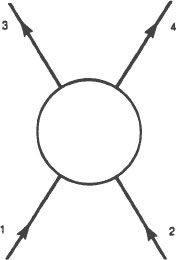
Not all interactions involve only two initial particles and two final particles. Below are some other forms that an S-Matrix diagram can take.
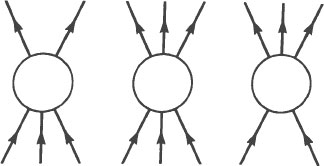
Like Feynman diagrams, S-Matrix diagrams can be rotated. The direction of the arrowheads distinguishes the particles from the anti-particles. Here is an S-Matrix diagram of a proton colliding with a negative pion to produce a proton and a negative pion.
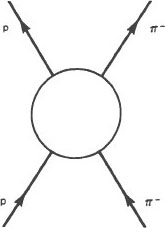
When this diagram is rotated it becomes a diagram of a proton/anti-proton annihilation producing a negative pion and a positive pion. (The positive pion is the anti-particle of the negative pion in the original reaction.)
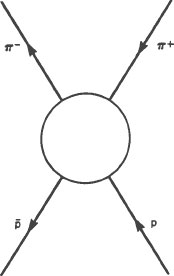
Every time a diagram is rotated it depicts another possible interaction. This particular S-Matrix diagram can be rotated four times. All of the particles that can be depicted by rotating a single element of the S Matrix are intimately related to each other. In fact,
all of the particles represented in an S-Matrix diagram (including those discovered by rotating the diagram) are defined in terms of each other
. Which of them are “elementary” is a meaningless question.
Since the particles resulting from an interaction often become involved in other interactions, separate elements of the S Matrix can be assembled diagrammatically into a network of related interactions. Each network, as well as each interaction, is associated with a certain probability. These probabilities can be calculated.
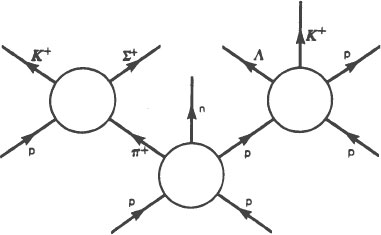
According to S-Matrix theory, “particles” are
intermediate states
in a network of interactions. The lines in an S-Matrix diagram are not the world lines of different particles. Lines in an S-Matrix diagram of an interaction network are “reaction channels” through which energy flows. A “neutron,” for example, is a
reaction channel
. It can be formed by a proton and a negative pion.
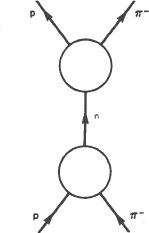
If more energy is available, however, the same channel can be created by a lambda particle and a neutral kaon, and several other particle combinations as well.

In short, S-Matrix theory is based upon
events
, not upon things.
*
,
†
Dancers no longer stand apart as significant entities. In fact, the dancers are not even defined except in terms of each other. In S-Matrix theory there is only the dance.
We have come a long way from Newton and his proverbial apple. Nonetheless, apples are a real part of the apparent world. When we eat an apple we are aware of who is eating and what is being eaten as distinct from the action of eating.
The idea that objects exist apart from event is part of the epistemological net with which we snare our particular form of experience. This idea is dear to us because we have accepted it, without question, as the basis of our reality. It profoundly influences how we see ourselves. It is the root of our inescapable sense of separateness from others and environment.
